Summary- Fed Caves – Bulls Run
- Sector & Market Analysis
- 401k Plan Manager
I could almost just reprint last week’s newsletter as not much changed during the week.
Importantly, the previous deep ‘oversold’ condition which was supportive of the rally following Christmas Eve has now been fully reversed back into extreme ‘overbought’ territory. While this doesn’t mean the current rally will immediately reverse, it does suggest that upside from current levels is likely limited.
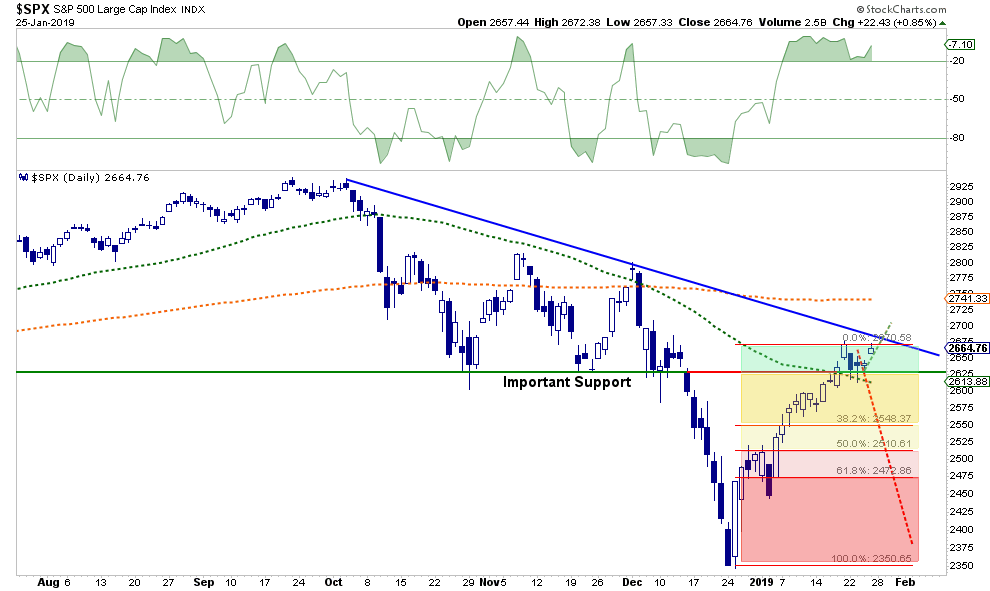
As I discussed previously, what was needed for the bulls to gain control of the narrative were several important issues:
- Central bank activity reverse from restrictive to accommodative,
- Washington to back off of “tariffs” and “trade war” rhetoric, and;
- The Federal Reserve to continue its more “dovish” stance.
Last weekend, we noted evidence of those changes. This week, the markets were given the clearest sign yet that the Fed, and Central Banks globally, were all too ready to come to the markets rescue.
It started with a WSJ article suggesting that the Fed would not only stop hiking interest rates but also cease the balance sheet reduction which has been extracting liquidity from the market. This was quite the change as noted in an early morning tweet.
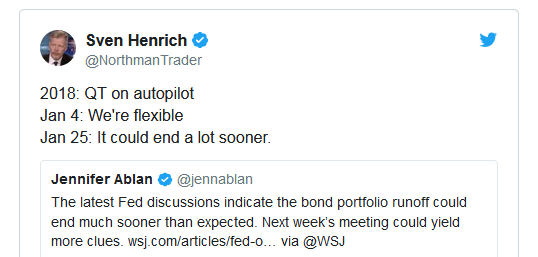
In mid-2018, the Federal Reserve was adamant that a strong economy and rising inflationary pressures required tighter monetary conditions. At that time they were discussing additional rate hikes and a continued reduction of their $4 Trillion balance sheet.
All it took was a rough December, pressure from Wall Street’s member banks, and a disgruntled White House to completely flip their thinking.
But the Fed isn’t alone.
China has launched their own version of “Quantitative Easing” to help prop up their slowing economy.
Lastly, the ECB downgraded Eurozone growth and there is a likelihood that not only will they not raise rates this year, they will also extend the TLTRO program. What is the TLTRO program?
Good question. It is the Targeted Longer-Term Refinancing Operations scheme which gives cheap loans to struggling Eurozone banks.
Think about this for a moment.
For a decade the global economy has been growing. Market participants are crowing about the massive surge in asset prices as clear evidence of the strength of the economy. As noted last week:
We’re the hottest economy in the world. Trillions of dollars are flowing here and building new plants and equipment. Almost every other data point suggests, that the economy is very strong. We will beat 3% economic growth in the fourth quarter when the Commerce Department reopens.
We are seeing very strong chain sales. We don’t get the retail sales report right now and we see very strong manufacturing production. And in particular, this is my favorite with our corporate tax cuts and deregulation, we’re seeing a seven-month run-up of the production of business equipment, which is, you know, one way of saying business investment, which is another way of saying the kind of competitive business boom we expected to happen is happening. – Larry Kudlow, Jan 24, 2019.
But yet, these “emergency measures” are STILL in place. Eurozone banks, global economies, and markets are still needing massive levels of support to stay afloat.
Yes, Kudlow is certainly “spinning the yarn” for the media to try and keep markets complacent. However, the Fed is clearly signaling their concern about “reality,” which as the data through the end of December shows, the U.S. economy is beginning to slow.
As shown, over the last six months, the decline in the LEI has actually been sharper than originally anticipated. Importantly, there is a strong historical correlation between the 6-month rate of change in the LEI and the EOCI index. As shown, the downturn in the LEI predicted the current economic weakness and suggests the data is likely to continue to weaken in the months ahead.
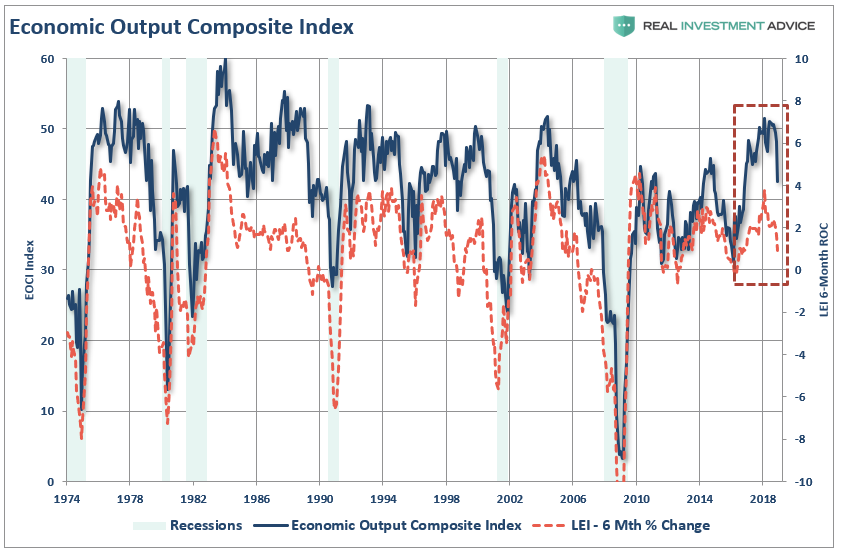
However, while the markets did respond bullishly to the news that the “Fed Put” was alive and well, the biggest issue facing the Fed will be the ongoing effectiveness of “Quantitative Easing” programs. As previously discussed:
Of course, after a decade of Central Bank interventions, it has become a commonly held belief the Fed will quickly jump in to forestall a market decline at every turn. While such may have indeed been the case previously, the problem for the Fed is their ability to ‘bail out’ markets in the event of a ‘credit-related’ crisis.
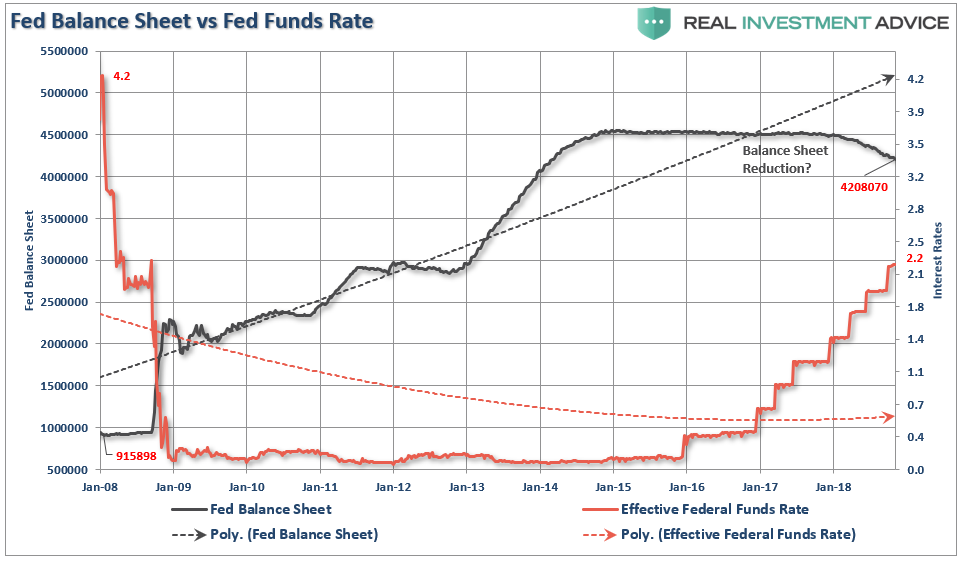
In 2008, when the Fed launched into their “accommodative policy” emergency strategy to bail out the financial markets, the Fed’s balance sheet was only about $915 Billion. The Fed Funds rate was at 4.2%.
If the market fell into a recession tomorrow, the Fed would be starting with roughly a $4 Trillion dollar balance sheet with interest rates 2% lower than they were in 2009. In other words, the ability of the Fed to ‘bail out’ the markets today, is much more limited than it was in 2008.
As an investor what you should be most concerned that it only a slight slowing in economic growth and just a 4.4% decline in the S&P 500 last year to send the Fed into “panic mode.”
The question you should be asking is what do they know that you don’t.
Bull In A Bear’s Den
Michael Lebowitz and I recently discussed the market in a broader sense for our subscribers at RIA PRO.
Use code “Bear Market” for a 1-MONTH free trial to RIA PRO.
You get access to our exclusive commentary, portfolios, and a ton of research data to help improve your investing.
From a technical short-term perspective, the recent bullish market action remains confined to a “bearish” trend currently. This keeps the risk/reward ratio unbalanced for aggressive equity exposure.
As shown, this past week, the market tested both its previous support of the October and November lows while maintaining above the 50-DMA. However, despite the news on Friday which pushed prices sharply higher, the market failed to break above its previous highs and still remains trapped below the downtrend line from the 2018 highs.
As I stated last week:
Importantly, while the market did break above the first level of resistance, it is currently NOT confirming the change to a bear market just yet. As shown in the chart below, the 2015-2016 correction ended when the market broke above, and successfully retested the 200-dma. That put the market back on a bullish price trend above that running moving average.

We are still a long way away from that happening.
Conclusion
The rally on Friday was based on the Fed will turn exceedingly “dovish” in their meeting next week. This could well wind up disappointing the markets.
Last week, we added equity exposure to our portfolios with the acquisition of some companies that we like the fundamentals of. However, we also swept a large portion of our trading cash into 1-3 month Treasury bills as the risk/reward for equities remains negative.
Even if you are exuberantly bullish, you should consider Mark Hulbert’s analysis from this past week:
The Dow Theory is still flashing a “sell” signal. Before this indicator can turn bullish again, the rally that has taken the Dow Jones Industrial Average almost straight up since its Dec. 24 low must end.
That’s why bullishly predisposed Dow Theorists should be hoping for a market pullback.
Though individual Dow Theorists disagree on the specifics of how to apply the Dow Theory in any particular situation, there is a broad consensus on what it takes to generate a buy signal:
1. Both the Dow Jones Industrial Average and the Dow Jones Transportation Average must undergo a “significant” rally after hitting new lows — “significant” both in terms of time and magnitude. This step has been satisfied by the market’s rally from the Dec. 24 lows.
2. Both of these Dow averages must subsequently undergo a “significant” correction of the rally referred to in step #1, and in this correction either one or both of these Dow averages must hold above their previous lows (Dec. 24). We are waiting for this step.
3. Both averages must rise then rise above their highs registered at the top of the rally referred to in step #1.
One of the lesser-appreciated aspects of this three-step process is that, without a “significant” pullback (step #2), a buy signal will never occur.
This is why we concluded last week by stating:
Overall, the weight of evidence suggests a retest of support at which time portfolios can be re-evaluated.
See you next week.
THE REAL 401k PLAN MANAGER
A Conservative Strategy For Long-Term Investors
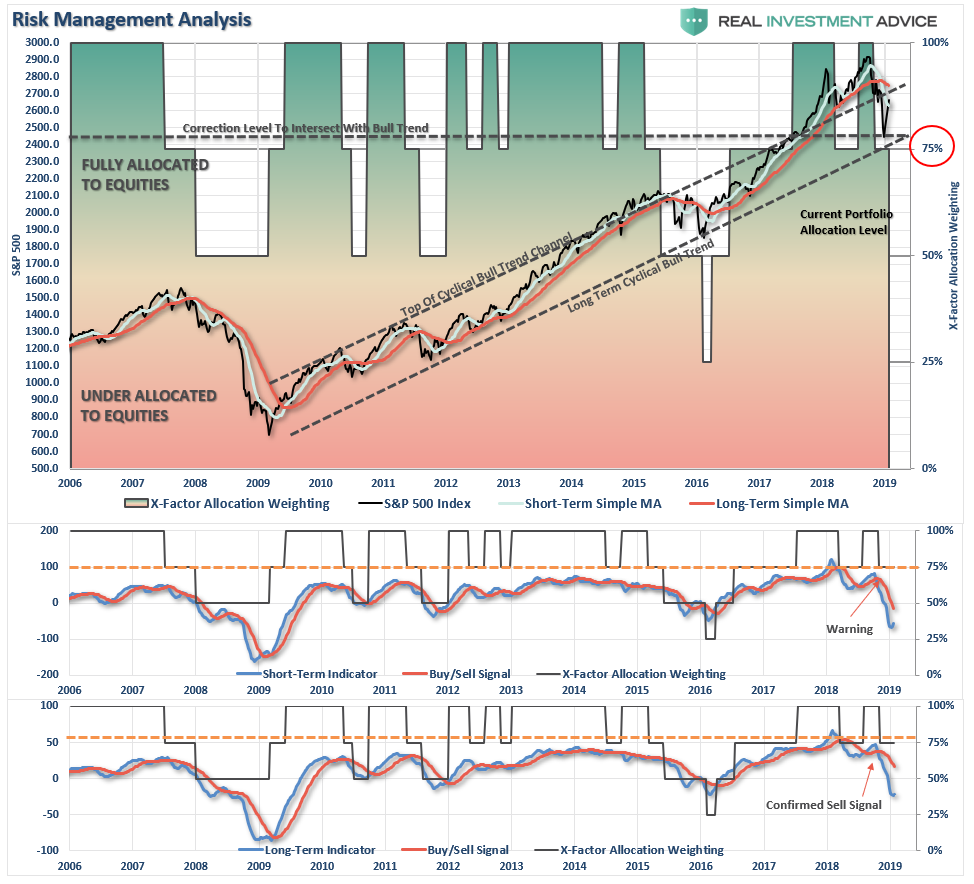
There are 4-steps to allocation changes based on 25% reduction increments. As noted in the chart above a 100% allocation level is equal to 60% stocks. I never advocate being 100% out of the market as it is far too difficult to reverse course when the market changes from a negative to a positive trend. Emotions keep us from taking the correct action.

Too Far, Too Fast
Over the last couple of weeks, we have watched a sharp rally in stocks as Washington, The Fed, and Global Central banks have put their best foot forward to provide a “put” underneath stock prices following the rout last year.
That continued to be the case this past week, but now the rally is pushing into exhaustion territory. We continue to recommend taking some action in plans if you haven’t done so already. We are going to get a correction, the only question is the timing of it.
- If you are overweight equities – reduce international, emerging market, mid, and small-capitalization funds on any rally next week. Reduce overall portfolio weights to 75% of your selected allocation target.
- If you are underweight equities – reduce international, emerging market, mid, and small-capitalization funds on any rally next week but hold everything else for now.
- If you are at target equity allocations hold for now.
Continue to use rallies to reduce risk towards a target level with which you are comfortable. Remember, this model is not ABSOLUTE – it is just a guide to follow.
Unfortunately, since 401k plans don’t offer a lot of flexibility and have trading restrictions in many cases, we have to minimize our movement and try and make sure we are catching major turning points.
We want to make sure that we are indeed within a bigger correction cycle before reducing our risk exposure further.

